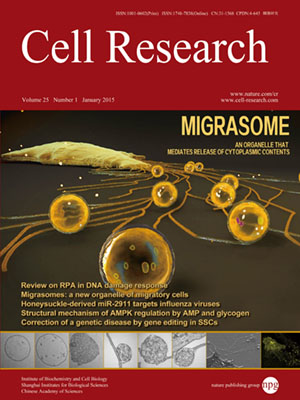
Volume 25, No 1, Jan 2015
ISSN: 1001-0602
EISSN: 1748-7838 2018
impact factor 17.848*
(Clarivate Analytics, 2019)
Volume 25 Issue 1, January 2015: 143-147 | Open Access
LETTERS TO THE EDITOR
H3K4me3 epigenomic landscape derived from ChIP-Seq of 1 000 mouse early embryonic cells
Jie Shen1,2,3,*, Dongqing Jiang1,3,*, Yusi Fu1,3,*, Xinglong Wu1,3,*, Hongshan Guo1,3, Binxiao Feng1, Yuhong Pang1,3, Aaron M Streets1,2, Fuchou Tang1,3 and Yanyi Huang1,2
1Biodynamic Optical Imaging Center (BIOPIC), Peking University, Beijing 100871, China
2College of Engineering, Peking University, Beijing 100871, China
3School of Life Sciences, Peking University, Beijing 100871, China
Correspondence: Yanyi Huang, E-mail: yanyi@pku.edu.cn; Fuchou Tang,(tangfuchou@pku.edu.cn)
Epigenetic regulation is crucial to the establishment and maintenance of the identity of a cell. Recent studies suggest that transcription is implemented amongst a mixture of various histone modifications1. It has also been recognized that to interrogate function of genetic information, comprehensively systematic profiling of the epigenome in multiple cell stages and types is required2. Chromatin immunoprecipitation (ChIP) has become one of the most critical assays to investigate the complex DNA-protein interactions3. Combined with profiling technologies such as microarrays (ChIP-on-chip) or high-throughput sequencing (ChIP-Seq), this assay becomes a great tool to study the epigenetic regulatory networks in cells4,5,6. However, the ChIP process produces limited amount of DNA due to the low yield of antibody pull-down, DNA damage during fragmentation and cleavage of DNA-protein complex, and complicated downstream analysis7. The conventional approaches have to consume a considerable amount of samples, typically 106 - 107 cells, to overcome this low-yield issue and obtain reliable results5. This limitation also restricts ChIP applications from precious primary tissue samples such as early embryonic cells or rare tumor stem cells.
10.1038/cr.2014.119
FULL TEXT | PDF
Browse 2635


